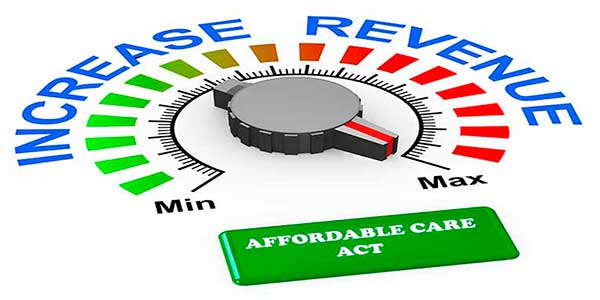Affordable Care Act Revenue
The Affordable Care Act is known for helping to make it possible for more people to afford health insurance coverage. But it is also a major revenue bill. The writers of the ACA knew the act would need continued funding to support many of the benefits the Act would provide both for the poor and the elderly.

Revenue Bill
The authors of the bill devised a number of taxes to help generate revenue and a carrot and stick approach to get people to purchase insurance. One tax is a 0.9 percent payroll tax on earnings over $200,000 for singles or $250,000 for couples. Another is a 3.8 percent tax on unearned income for higher-income taxpayers.
Taxes are projected to bring in $210 billion dollars over a 10-year period from 2010 through 2019.
A repeal of taxes on the wealthy is expected to be corner stone of any Republican healthcare plan.
The law also includes taxes on a number of unusual items. Like a 10 percent tax on tanning-bed services. Pharmaceutical companies and even the health insurance companies pay more taxes.
Update Feb. 2, 2017
The Associated Press came out with an article that suggests close to $1.1 trillion in taxes will be collected over 10 years. The numbers are difficult to understand since they cover different 10-year periods for different taxes. The article suggests $79 billion will be collected for the "Cadillac" tax. The "Cadillac" tax has been repeatedly postponed. We believe earlier estimates of $210 billion for a 10-year period ending in 2019 are relevant at this time. Whatever calculation methods you use it is still a lot of money.
Taxes at a glance
• 0.9% Increase in Medicare Tax Rate for individuals earning over $200,000 or couples over $250,000.
• 3.8% Medicare tax on investment income for individuals earning over $200,000 or couples over $250,000. Investment income includes: gross income from interest, dividends, royalties, rents, and net capital gains.
• 85% of people with health insurance earn less than $250,000 a year so these taxes have little effect.
• A tax on health insurance companies selling expensive plans. A 2.3% tax on manufactures of and importers of brand-name drugs and medical devises. All together these taxes are estimated to raise $87 billion over 10-year period.
• Device makers strongly complained. Congress voted to suspend the tax for 2016 and 2017. It was reinstated in 2018, with device manufactures crying up a storm.
• The hurdle to get over for deducting medical expenses not covered by insurance was raised from 7.5% to 10% of Adjusted Gross Income. A temporary exemption was in place for seniors over 65. They could still claim at the lower rate for expenses through the end of 2016. Going forward it is unclear if this exemption will be extended.
• Flexible Spending Arrangements have a new lower contribution limit of $2,500. FSA are a nice perk for people with sufficient income to fund such arrangements. The poor never benefited from these schemes so they were not adversely affected when tax advantages were scaled back.
• Starting from 2011, the cost of an over-the-counter medicine or drug could not be reimbursed from Flexible Spending Arrangements (FSAs) or Health Reimbursement Arrangements (HRAs) unless a prescription is obtained first.
• There is a 10% tax on indoor tanning services, a kind of luxury tax. Perhaps a few more people will go outside and enjoy nature more.
• Cadillac tax – this was supposed to be a tax imposed on employer sponsored plans that provide benefits considered to be “too” good. This tax have never been enforced. It is an easy target for repeal.
July 17, 2019 - The House voted 419 to 6 to repeal the Cadillac tax.
• Individual mandate requires people to pay a penalty for not having health insurance. Most people would consider this the same as a tax ( 2.5 percent of your annual income or $695 in 2016, whichever is higher). Approximately 6.5 million people are expected to pay the penalty for 2016 tax year for an estimated $3 billion in fees.
• In the final days of 2017, the GOP passed tax reform which included a provision to eliminated the individual mandate. Starting from 2019, there would no longer be a penalty for not having health insurance.
• Larger employers (more than 50 full-time employees) will be charged a $2,000 penalty per full-time employee that lacks health coverage.
• For tax years 2010 and 2011, the Affordable Care Act raised the maximum adoption credit per child and the credit was refundable. This is a positive benefit for people adopting or looking to adopt.
• Health coverage for an employee's children under 27 years of age is now generally tax-free to the employee.
• The ACA also requires all health insurance issuers and self-insured group health plans to make contributions under the Transitional Reinsurance Program to support payments to individual market issuers that cover high-cost individuals.
Where does the money go ?
Around $40 billion goes to provide subsidies for close to 11 million lower income people to purchase health insurance. Money also goes to help pay for expanded Medicaid cover for another 10 million people. Money goes to help provide new benefits to Medicare recipients like expanded preventive benefits and to help with reducing the prescription drug coverage problem called the “donut hole.”
♦ The Affordable Care Act revenue is used to fund many more programs that the public has little knowledge of. If a repeal does take place and funding is cut off then people will take notice.
One such fund is called the federal Prevention and Public Health Fund. It is a multi-million dollar fund that uses money for many public causes, not all of which the GOP agrees with. The Center for Disease Control and Prevention is a major recipient, using the money to promote immunization programs and to help fight Zika, Ebola and influenza among other things.
The Affordable Care Act also provides credits for small businesses called health care tax credits. The credits in effect reduce revenues but they help small businesses and small tax-exempt organizations afford the cost of covering their employees. The credit is to encourage small employers to offer health insurance coverage for the first time or maintain coverage they already have. In general, the credit is available to small employers that pay at least half the cost of single coverage for their employees.
What lies ahead ?
The news out of Washington is very mixed and confusing. All Republicans are united in their hate for Obamacare but they cannot agree on what to do. The Affordable Care Act is a massive law that reachs far and wide into the healthcare system. It has driven a lot of positive changes but it has roughed a lot of feathers in the process.
Deciding who benefits from healthcare reform and who doesn’t is split along ideological lines. It is hoped a common ground can be found, but an insurmountable barrier exists between our two main political parties right now.

